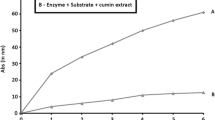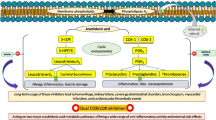Abstract
The overproduction of pro-inflammatory mediators is controlled by leukotrienes, viz. the 5-lipoxygenase inhibitors. These hold therapeutic importance in the treatment of a range of diseases such as rheumatoid arthritis, asthma, inflammatory bowel infection, and some forms of cancer. Owing to this, there has been an increase in the exploration of competent therapeutic agents meant for protein 5-lipooxygenase and at present, this practice is largely dependent on Quantitative Structure–Activity Relationship (QSAR). Nucleophilicity index is a significant electronic parameter which plays a crucial part in such studies. In this work, QSAR models are developed for some derivatives of benzoquinone in terms of nucleophilicity index invoking regression approach. The study entails prediction of inhibitory activity in terms of inhibitory concentration. Robustness and predictability of the nucleophilicity index–QSAR model is tested through cross-validation and test set activity prediction. Satisfactory results are produced by the model presenting the reliability of using nucleophilicity index as descriptor for inhibitory activity studies. It is, however, recommended that for future studies the above descriptor should be employed together with other relevant descriptors.
Graphical abstract







Similar content being viewed by others
References
Jakschik BA, Lee LH (1980) Nature 287:51
Funk CD (2001) Science 294:1871
Haeggstrom JZ, Funk CD (2011) Chem Rev 111:5866
Ghosh J, Myers CE (1997) Biochem Biophys Res Commun 235:418
Ghosh J (2003) Biochem Biophys Res Commun 307:342
Hennig R, Grippo P, Ding XZ, Rao SM, Buchler MW, Friess H, Talamonti MS, Bell RH, Adrian TE (2005) Cancer Res 65:6011
Melstrom LG, Bentrem DJ, Salabat MR, Kennedy TJ, Ding XZ, Strouch M, Rao SM, Witt RC, Ternent CA, Talamonti MS, Bell RH, Adrian TA (2008) Clin Cancer Res 14:6525
Chen Y, Hu Y, Zhang H, Peng C, Li S (2009) Nat Genet 41:783
Young RN (1999) Eur J Med Chem 34:671
Werz O, Steinhilber D (2005) Biochem Pharmacol 70:327
Wenzel SE, Kamada AK (1996) Ann Pharmacother 30:858
Liu MC, Dube LM, Lancaster J (1996) J Allergy Clin Immunol 98:859
Steinhilber D, Hofmann B (2014) Basic Clin Pharmacol Toxicol 114:70
Tandon H, Chakraborty T, Suhag V (2019) Res Med Eng Sci 7:791
Tandon H, Chakraborty T, Suhag V (2019) Chem Biomol Eng 4:45
Tandon H, Chakraborty T, Suhag V (2020) Found Chem 22:335
Balasubramanian K (2022) Computational and artificial intelligence techniques for drug discovery & administration. In: Kenakin T (ed) Comprehensive pharmacology. Elsevier, p 553
Balasubramanian K (2018) Curr Top Med Chem 18:2774
Eren G, Macchiarulo A, Banoglu E (2012) Mol Inf 31:123
Sharma MC (2014) Med Chem Res 23:1797
Aparoy P, Suresh K, Reddy KK, Reddanna P (2011) Bioorg Med Chem Lett 21:456
Ul-Haq Z, Khan N, Zafar SK, Moin ST (2016) Eur J Pharm Sci 88:26
Filosa R, Peduto A, Schaible AM, Krauth V, Weinigel C, Barz D, Petronzi C, Bruno F, Roviezzo F, Spaziano G, Agostino BD, De Rosa M, Werz O (2015) Eur J Med Chem 94:132
Masayuki F, Tanihiro Y, Kenkichi O, Shozo Y (1984) Biochim Biophys Acta Lipids Lipid Metabol 795:458
Lee EJ, Kim JS, Kim HP, Lee JH, Kang SS (2010) Food Chem 120:134
Schewe T, Kühn H, Sies H (2001) J Nutr 132:1825
Roy K (2004) Mol Diversity 8:321
Agrawal VK, Gupta M, Singh J, Khadikar PV (2005) Bioorg Med Chem 13:2109
Huilgol MI, Sriram V, Balasubramanian K (2022) Mol Phys 120:e1987542
Parr RG, Pearson RG (1983) J Am Chem Soc 105:7512
De Proft F, Liu S, Parr RG (1997) J Chem Phys 107:3000
Tandon H, Chakraborty T, Suhag V (2019) J Mol Model 25:303
Tandon H, Ranjan P, Chakraborty T, Suhag V (2021) Mol Diversity 25:249
Tandon H, Chakraborty T, Suhag V (2021) Theor Chem Acc 140:105
Tandon H, Yadav P, Chakraborty T, Suhag V (2022) J Organomet Chem 960:122229
Tandon H, Chakraborty T, Suhag V (2019) Int J Quant Struct-Prop Relat 4:99
Chattaraj PK, Maiti B (2001) J Phys Chem A 105:169
Minitab 17 Statistical Software (2010) [Computer Software] Minitab, Inc., State College, PA (www.minitab.com)
Hawkins DM, Basak SC, Mills D (2003) J Chem Inf Comput Sci 43:579
Acknowledgements
Dr. Tanmoy Chakraborty is thankful to Sharda University for providing computational and a research facility.
Author information
Authors and Affiliations
Corresponding authors
Additional information
Publisher's Note
Springer Nature remains neutral with regard to jurisdictional claims in published maps and institutional affiliations.
Supplementary Information
Below is the link to the electronic supplementary material.
Rights and permissions
About this article
Cite this article
Yadav, P., Tandon, H., Malik, B. et al. A study of 5-lipoxygenase inhibitors invoking DFT-based descriptor nucleophilicity index. Monatsh Chem 153, 651–656 (2022). https://doi.org/10.1007/s00706-022-02953-5
Received:
Accepted:
Published:
Issue Date:
DOI: https://doi.org/10.1007/s00706-022-02953-5




